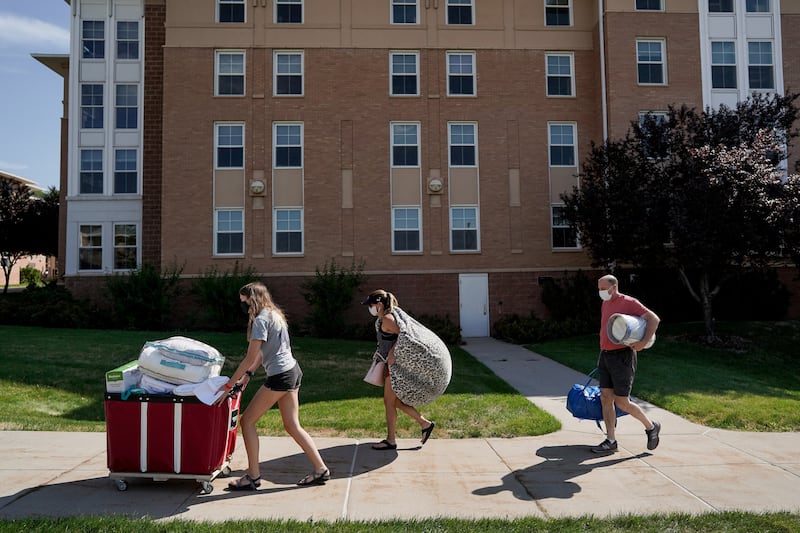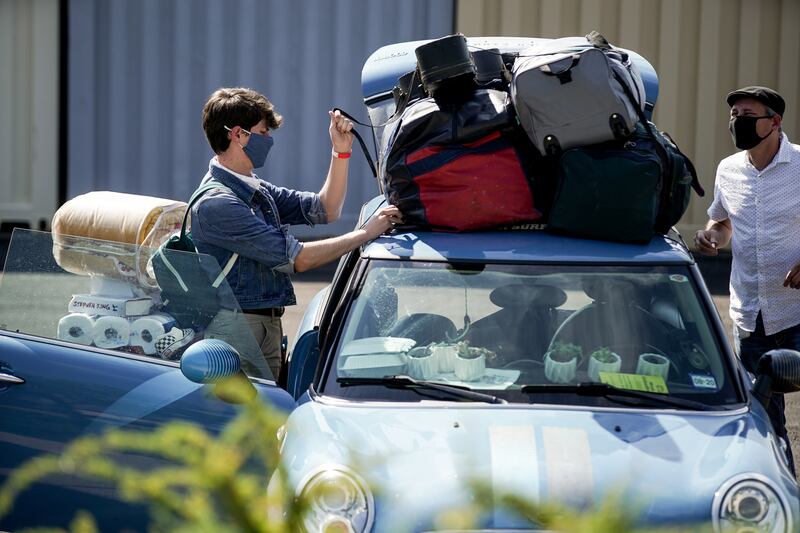SALT LAKE CITY — One week.
That’s how long the doors of the University of North Carolina at Chapel Hill remained open for its fall 2020 term, which began Aug. 10. The Monday after — and over 175 positive COVID-19 tests later — the university declared the situation “untenable” and said it would transfer all courses online effective Wednesday.
Notre Dame finds itself in a similar situation, with in-person undergraduate classes canceled for the next two weeks after nearly 150 students tested positive for COVID-19, according to the Associated Press.
With a number of Utah colleges returning, at least partially, to in-person education over the next few weeks, the question lingers as to whether they can do any better.
Robert Wagner, the vice president of Academic and Institutional Services at Utah State University, said a large part of USU’s plan to stay open is remaining partially closed.
Student registration for classes with some level of in-person instruction are around 40%, he said, which is lower than the average of around 70-80%.
“So that has dropped almost by half, which makes sense, because our classroom capacity with our social distancing protocols is right around 20-25% of our normal capacity,” he said.
Additionally, around 35% of student registrations were for fully online classes, which is higher than the average of about 15-18%, according to Wagner.
Only 14% of USU classes will be held exclusively in person, and most that choose to are labs or other courses which can’t be easily transferred online.
The decisions as to how classes are taught were left mostly up to the faculty and their academic departments, Wagner said. They were the ones who determined which courses could be moved online and which should be kept as a hybrid or in-person courses.
Other practices intended to limit the spread of COVID-19 have also been added. Classrooms will be sanitized twice a day, once in the evening or morning and once in the middle of the day. Masks will be required, as will the practice of social distancing while on campus.
“One of the benefits of having the many different course delivery methods that we have at Utah State University is we’re confident that if a student doesn’t want to wear a mask and participate in an in-class experience, that we can find courses where they can connect remotely,” Wagner said.
The university will also ask students who do not feel well not to come to class.
Wagner did not know what kind of virus testing USU would be doing or how often.
“We’ve heard very clearly from many of our students who want to come back,” Wagner said. “They want to be in an environment where they are with their student peers, where they are also with their faculty.”
To do so, it will take everyone in the “institutional community” doing their part and proving they want to keep classes in person.
The way they do it?
Obey the university’s rules, even while at home or away from campus, Wagner said, emphasizing the need for personal accountability and playing as a team.
The university has an online pledge where students, faculty and staff can add their names, promising to do the following:
- Follow all Centers for Disease Control and Prevention and university updates on health and safety guidelines and procedures.
- Participate in testing and contact tracing to stop the spread of COVID-19 and preserve the wellness of the USU family.
- Report if I am seeking testing or if I’ve tested positive to USU Risk Management by submitting the COVID-19 questionnaire.
Westminster College
Westminster College is implementing similar rules and practices for their campus as students return, with classes beginning Aug. 19.
Like USU, Westminster will hold a mixture of in-person, hybrid and remote classes during the fall, which officials said could be helpful should circumstances worsen.
“Faculty have spent the entire summer designing a curriculum that is very flexible, and we’re trying to stay nimble, so that if we do have to make a change we can do that in a much easier way than what we all experienced back in the spring,” said Arikka Von, the director of strategic communication at Westminster.
Class enrollments were capped based on the size of the classrooms where they’ll be held to keep students and faculty socially distanced from one another.
Additionally, face masks will be required in all indoor spaces, and the college has added some outdoor areas where classes can be taught.
The frequency of sanitizing and wiping down of surfaces has also increased at Westminster, according to Von.
And, again, a large portion of the onus for keeping the campus open and classes face to face falls on the college’s community, even when they’re away from campus.
“We obviously cannot control what anyone — faculty, staff or a student — does away from campus,” Von said. “We are really hoping, we are asking everyone to do this. Because it’s our shared responsibility, and that’s a message that we’ve been sharing across campus: I’m wearing a mask for you, I hope you wear one for me. And we want to be able to continue as a community in this pursuit of education. And for us to do that, we have to do that together.”
There are differences among the colleges in Utah, which make reopening more feasible or less for the various schools.
“I wouldn’t say this is easy for anyone,” Von said, “but I think our small class sizes and our ability to be a little more flexible as a private, independent college has its benefits.”
Repercussions for students
UNC freshman Mackenzie Holland cried when she heard in-person classes had been canceled and that she’d be moving from the dorm she’d moved into just weeks prior, the AP reported.
“I kind of expected it, but I’m just kind of disappointed in my classmates and the people that are out partying and stuff because now I can’t finish my college experience,” Holland said. “I know that we’ll be back one day, but it’s just sad right now.”
Students — as well as their colleges — have adhered to CDC guidelines to varying degrees of diligence.
“My friends are all over. Their schools aren’t really doing any precautions. My friend has already gone to, like, four parties,” said Jude Thompson, 18, a freshman from Texas who moved into University of Utah’s dorms Tuesday. “He got there yesterday.”
The repercussions of canceled school and housing are felt to varying degrees by students.
“It’s not really a concern just because I always have a home,” said U. freshman Kiara Romero, who’s from Taylorsville, about the possibility of being booted from the dorms. “It’s not really big of an issue; I don’t live out of state or anything.”
But for the students who come from outside Utah, like Thompson, the consequences of a university quickly canceling in-person education — and housing — are severe.
Thompson’s father, Jamie Thompson, said he hopes if the university does have to shut down that it doesn’t send students home right away.
“Even if they didn’t send the students home if there was an outbreak, and just quarantined them to their rooms and just had them study from their rooms here,” he said, “I think they could probably bring the numbers back down. I almost think it would be overkill to send everyone all the way back to the states where they’re from.”
The incoming freshmen are hopeful that their first taste of college isn’t soured by others’ decisions.
“When the state highly suggested staying indoors, I knew so many people who were going out and throwing parties to kind of revive their senior years, which is so unfair, because then there are people like us who have been quarantining since March,” Jude Thompson said. “I was honestly angry for a bit. Now, it’s honestly a little hopeful, I guess. I can’t get back to high school, but I can start making some new memories in college.”
Whether he will get the chance to or will instead be moving back home in the coming weeks will depend on whether his college can find answers that UNC and Notre Dame, thus far, have not.



